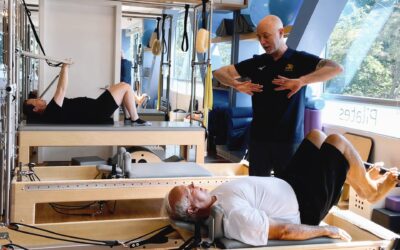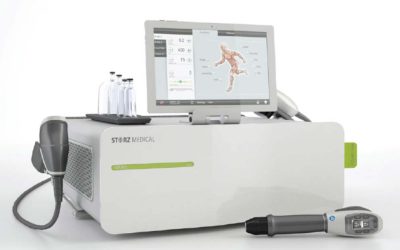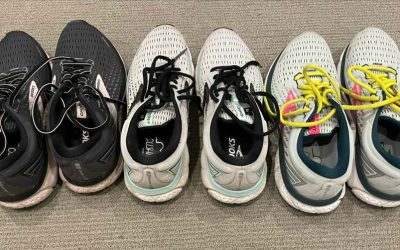What is a Diastasis Rectus Abdominus (DRA)?
DRA is a separation of the bellies of the rectus abdominis muscle, the muscle commonly known as your “six- pack” muscle. Separation of this muscle can occur in both women and men. In women the most common cause is pregnancy – with the expansion of the abdomen there can be stretching of the connective tissue of the abdominal wall (the linea alba) that results in a separation. 66% of women have a DRA in the third trimester of pregnancy.
DRA is less common in men but can happen as a result of poor training technique or overloading of the abdominal wall from sports or training techniques. In both men and women, muscle imbalances around the midback, ribcage and abdomen can create excessive intra-abdominal pressure (IAP) that can increase loads on the linea alba.
How Can I Tell if I Have a DRA?
 The separation of the muscle bellies is present at rest, but is most easily detected during a curl-up. Lying on your back, lift your head and shoulders off the floor and feel along the mid-line of your stomach, feeling for any separation or softness between the muscle borders. Bulging or doming of the abdominal contents can occur through the separation, or there may be a hollow that can be felt between the muscle bellies. Use one hand to feel the midline of your stomach, and place the other hand lower on your belly to feel for pushing out of your tummy from pressure.
The separation of the muscle bellies is present at rest, but is most easily detected during a curl-up. Lying on your back, lift your head and shoulders off the floor and feel along the mid-line of your stomach, feeling for any separation or softness between the muscle borders. Bulging or doming of the abdominal contents can occur through the separation, or there may be a hollow that can be felt between the muscle bellies. Use one hand to feel the midline of your stomach, and place the other hand lower on your belly to feel for pushing out of your tummy from pressure.
Do you feel softness in the midline, bulging or doming, or pressure in your lower abdomen? Not to worry, we can help!
What Can be Done to Treat Someone with a DRA?
Lots!
First of all, it’s important to understand that there are several influences from different regions of your body that can result in your DRA bulging, widening or feeling loose. Your past injuries and how you have compensated and adapted to them can play a role. If you played a lot of one sport, you may have muscle imbalances you developed that also are contributing. Even things like previous ankle sprains and foot injuries can affect how you use your trunk and abdominal muscles.
Because everyone is different, if you have a DRA, what’s most important is that we do a thorough, whole body assessment to determine all the influences that affect your DRA. Everyone has a different movement history – sports they played, injuries they’ve had – that all influence how you use your muscles of your thorax, pelvis and abdomen.
This is one of the ways, at Synergy Physio + Pilates, we treat DRA differently – we assess your whole body, including the function of your pelvic floor and your breathing, to determine the treatment plan that you specifically need. This is also true for how we treat hernias and support hernia repairs – we figure out how your movement patterns contributed to loading the hernia site and how you can ensure full recovery without recurrences.
From our functional assessment and unique diagnostic, we can determine where in your body is the most important region to treat and to train in order to improve your DRA – we call these important regions your “Drivers”. Read more about Drivers and ConnectTherapy here:
People with a DRA and hernias often have a poorly functioning deep core (transversus abdominis, pelvic floor, diaphragm and deep multifidus) and use compensatory strategies that make the diastasis worse. They may overuse superficial abdominal muscles such as the internal oblique muscle, which can widen the diastasis. They may hold their breath when they transfer loads through their spine and pelvis, or have muscle imbalances around the thoracic rings that create excessive increases in intra- abdominal pressure (IAP) that puts further stress on the DRA.
Specific assessment is required to determine all the factors contributing to the DRA, the integrity of the abdominal wall linea alba fascia, and the muscle imbalances that are present. This assessment also determines how your pelvis and spine are transferring loads and whether the DRA is related to your back pain, incontinence, or prolapse. An internal pelvic floor exam may be recommended, depending on our findings from our initial ConnectTherapy™ assessment.

Left – image of Rectus Abdominis heads & connecting Linea Alba (LA) at rest. Right – same image but during a Curl-Up – the LA maintains tension and connection during the functional task, which is the optimal response.
We also are one of the few clinics in the Lower Mainland that use Rehabilitative Ultra- sound Imaging (RUSI) assessment of your abdominal wall. The ultrasound enables us to see how your linea alba is responding to loads and abdominal contractions. Clinical Director, Physiotherapist Dr. LJ Lee, has been using and training staff in RUSI for almost 20 years and developed the comprehensive assessment protocol for patients with DRA used here at Synergy Physio + Pilates. Imaging your abdominal wall allows us to see the function of your muscles in real-time and is an important part of DRA assessment.
Once an assessment is performed, a specific treatment plan to treat your Drivers & balance the abdominal wall will be prescribed, along with teaching you new strategies for transferring loads through the thorax, pelvis and spine so both the organs and the joints are supported and can function optimally. In some cases the DRA gets smaller, and in other cases it doesn’t close but there is greater tension across the linea alba during function and there is a full return to activities without pain, incontinence or prolapse. Occasionally, in some cases, surgery may be needed, and our assessment enables us to determine when that is the case.
Can Exercise Make my Diastasis Worse?
In a word, yes. If you use non-optimal muscle patterns during your exercises, and create forces that further stretch the diastasis, the diastasis may get worse, or at the least, not improve.
After pregnancy it is important to support the abdominal wall fascia to allow it to heal and tighten up. Starting vigorous exercise too soon (within the first 2 months postpartum) can put too much load on the body and lead to more problems in the future. If you are using your abdominal muscles and trunk muscles in non-optimal ways, or if your deep core is not working properly, it is important to get a comprehensive assessment before returning to your exercise program.
We feel that all women post-partum should have a full body assessment and be given education and exercises to help them in their recovery from pregnancy & delivery – it’s a big event for your body!
If you think you have a DRA, or if you are more than 8 weeks postpartum and are struggling with any of the following symptoms:
- back pain, pelvic pain, or groin pain
- leaking urine, gas or stool with laughing, coughing, jumping, sneezing, etc.
- leaking urine or stool when you feel a strong urge to go
- pressure or bulging in your vagina or rectum
- bulging of your abdomen during any exercise that you can’t change
- inability to return to normal activity levels because of pain or leaking
- difficulty returning to activity after a hernia repair without feeling pressure or pulling on the hernia site
then you should have a complete functional, neuromuscular, and ultrasound assessment done by one of our team. This assessment will determine what type of treatment is best for you. Talk to our Front Desk about which therapist is right for you, or read more about our Team here.
You don’t need to live with these problems – let us help you Move Better, Feel Better and Be Better.
Our Blog
Insights and Tips from Our Experts
Next Group Physio Healthy Bones™ Class starts Wed. Sept 13th – Sign up now!
Are you interested in improving your balance, stability, muscle strength and bone health? Then this class is for...
Shockwave Therapy – What is it & How can it help?
Shockwave therapy has become increasingly common as a treatment option for musculoskeletal conditions to assist...
Running and Pregnancy
Running has become a very popular sport, and more than half of recreational runners are women. For runners who...



